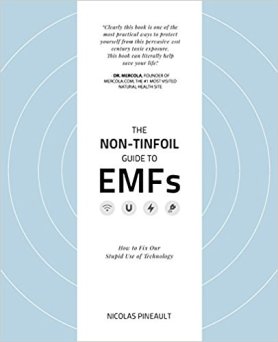
The Non-Tinfoil Guide to EMFs – Nicolas Pineault
(Buy from Amazon; Buy from The Book Depository)
Can you really feel years younger & make unexplained symptoms vanish with the click of a button — the “Airplane Mode” on your cell phone?
Investigative Health Journalist Nicolas Pineault used to think this all sounded like something only crazy people wearing tinfoil hats would say.
But the overwhelming amount of independent scientific evidence linking electromagnetic fields (EMFs) from wireless technologies with increased risks of cancer, infertility, insomnia, and depression sure has the uncanny ability to change a man’s mind.
The Non-Tinfoil Guide to EMFs is a simple and unconventional book that will teach you exactly how to reduce your exposure to this brand new 21st-century pollution without going back to the Stone Age.
You will learn:
- What your smartphone, your wifi router and your microwave oven have in common (page 9)
- Why policy makers and scientists all worldwide don’t agree about whether EMFs are dangerous or not (page 21)
- Is Electro-Hypersensitivity as popularized in the TV show “Better Call Saul” real? Or is it all psychological? (page 62)
- Why carrying a cell phone in your pocket can harm your fertility (201 studies prove it) (page 72)
- The 1-click fix to reduce cellphone EMFs by 84% (page 142)
- What is safer? Speakerphone, earbuds or a Bluetooth ear piece? (page 155)
- The #1 worst source of EMF radiation at home (page 160)
- Why baby monitors are worse than smartphones, and better alternatives (page 208)
It’s true. The jury is still out about whether cellphone radiation is the new smoking or just a temporary scare. But why take chances?
Instead, read The Non-Tinfoil Guide to EMFs — the technological seat belt you might just need to use your new gadgets safely.
Disclaimer: This page contains affiliate links that may provide monetary compensation to help support the Whole Guidance Vision of Creating a Happy and Healthy Planet should you make a purchase. We very much appreciate and thank you for your support.
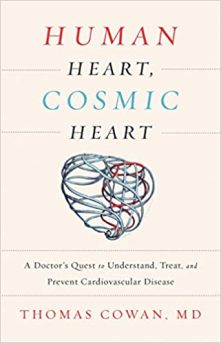
Human Heart, Cosmic Heart – Dr Thomas Cowan MD
(Buy from Amazon; Buy from The Book Depository)
Thomas Cowan was a 20-year-old Duke grad―bright, skeptical, and already disillusioned with industrial capitalism―when he joined the Peace Corps in the mid-1970s for a two-year tour in Swaziland. There, he encountered the work of Rudolf Steiner and Weston A. Price―two men whose ideas would fascinate and challenge him for decades to come.
Both drawn to the art of healing and repelled by the way medicine was―and continues to be―practiced in the United States, Cowan returned from Swaziland, went to medical school, and established a practice in New Hampshire and, later, San Francisco. For years, as he raised his three children, suffered the setback of divorce, and struggled with a heart condition, he remained intrigued by the work of Price and Steiner and, in particular, with Steiner’s provocative claim that the heart is not a pump. Determined to practice medicine in a way that promoted healing rather than compounded ailments, Cowan dedicated himself to understanding whether Steiner’s claim could possibly be true. And if Steiner was correct, what, then, is the heart? What is its true role in the human body?
In this deeply personal, rigorous, and riveting account, Dr. Cowan offers up a daring claim: Not only was Steiner correct that the heart is not a pump, but our understanding of heart disease―with its origins in the blood vessels―is completely wrong. And this gross misunderstanding, with its attendant medications and risky surgeries, is the reason heart disease remains the most common cause of death worldwide.
In Human Heart, Cosmic Heart, Dr. Thomas Cowan presents a new way of understanding the body’s most central organ. He offers a new look at what it means to be human and how we can best care for ourselves―and one another.
Disclaimer: This page contains affiliate links that may provide monetary compensation to help support the Whole Guidance Vision of Creating a Happy and Healthy Planet should you make a purchase. We very much appreciate and thank you for your support.
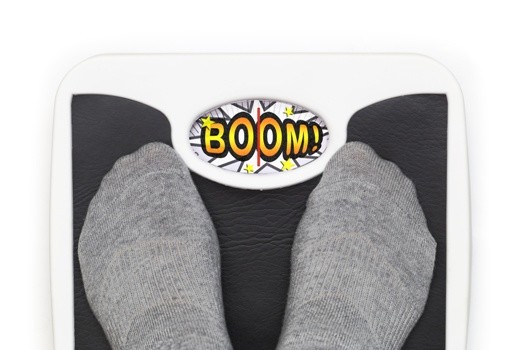
Podcast: Play in new window | Download
In this podcast I’ll be exploring the Best Ways to Measure Your Health:
- I’ll explain why tracking your health progress is crucial to reaching your health goals
- I’ll talk about how your body weight is really a poor measure of health
- Finally, I’ll give you 5 different health tracking techniques you can use to better manage your health
CLICK HERE TO LEARN WHAT ARE THE BEST FOODS TO GET YOU LEAN
Many people set health goals and fail to reach them, why? Two big reasons come to mind. First one is you need to know why you are doing what it is you are doing. Many people fail to reach health goals because they don’t have a big enough why, a big enough reason to push through plateaus and obstacles that will most definitely show up. Having a dream gives you that why; it gives you direction and inspiration to push through right to the end.
Second big reason people fail to meet health goals is that they do not track their health progress. Just as having a dream and setting a health goal is important in that it gives you direction and something to move toward and gives you that drive and that push, tracking your health progress is like signs and indicators that keep you on the best path toward your dream. Tracking and measuring your health is really important in that it gives you clear signs when things are working for you and when things are not.
If you suffer from chronic weight issues, whether you’re overweight or underweight, than the bathroom scale is probably your most prized and most despised earthly possession and why wouldn’t it be. You have been told that body weight is a very important indicator for health. Let explain how this is not 100% accurate.
Your body weight is made up of muscle, bone, fat, cartilage, bodily fluids of several types, and of course water. Whenever you stand on a scale and measure your weight you are weighing the totality of all of these things. This is where the Body Mass Index or BMI fails as a health measurement. The BMI is a measure of body fat (supposedly) based on your weight in relation to your height. If your BMI comes out at 18.5-24.9 you are labelled as having a normal weight. If its 25-29.9 you are labelled overweight. Over 30 and you’re obese.
Now I want you to think of the Terminator himself Arnold Schwarzenegger. During his bodybuilding days his body weight was around 107 kg or 235 lbs and he’s 6’2”. Arnold’s BMI in his prime works out to be 30.2. Meaning according to body weight and BMI that Conan, the Commando himself who helped Red Sonja save the world and who single-handedly took out the Predator is an obese fat hunk of human flesh! Remember over 30 is obese. Well of course that’s not true as Arnold’s body fat percentage when he was competing was only about 5-7% and he was in reality a mass of lean muscle and a chiselled piece of human art.
The bathroom scale is not giving you an accurate number for health. It’s giving you a number, but that number depends on so many things. Is that scale number made up of mostly muscle which is a lot more dense and heavier and healthier than fat? Or is it bone mass? Is that scale number mostly fat?
Imagine you spend a whole month off the sugars and junk food, you’ve quit smoking, and you’re now walking more and doing some resistance training. You start out at 70 kg and after 4 weeks you see on the scale the same 70 kg. Your initial reaction may be shock, horror, and confusion, but if you understand that getting off the sugars means you’re not holding onto as much water as before and that eating more real food and not smoking and doing some weight training can actually build muscle and bone and cause fat cells to empty out and die then maybe that number is a really good indication of how you’ve been doing that month. You’ve burnt off the fat and you’ve built up some bone and muscle.
This is why body weight is not a good measurement to track and using a scale is a waste of time really. It’s difficult to get a real sense of what’s happening with your body and with your health overall when you rely solely on that number you get from the scale.
Let me share 5 more effective ways to track your health progress. These techniques do not need any fancy equipment and are simple and easy to do and they will give you a more accurate measure of your health than a body weight number on a scale ever could.
First technique is measuring your waist-to-hip ratio. This gives you a better measurement of your body composition. All you need is a tape measure and a calculator. Note down your waist circumference (by putting the tape around your waist over your belly button) and your hips circumference (by measuring at the widest part of your hips). Divide your waist measurement by your hips and you will have your waist-to-hip ratio. An ideal number for men is 0.8 and for women is 0.7. Less than 0.95 for men and less than 0.8 for women puts you in the low risk disease group. Above these numbers, .95 and above for men, .8 and above for women and you move into the moderate and high risk disease groups.
Along this body composition line of thinking clothes are a great way to track progress. Are your pants or dresses starting to feel more loose or tight? If it’s tight is it due to more fat or more muscle tone? How to tell? Use a mirror and a camera. Your memory tends to be a bit biased and flaky when it comes to your body image so taking photos of your half-naked body in the mirror is a great objective assessment of your body composition over time. I suggest keeping the snaps to once a week. You can overdo tracking your health progress. We want to keep it nice and balanced so once a week taking your measurements will keep you from getting too neurotic.
Second way to track your health progress is by keeping a food and poop log. This is seriously important data you need to manage to keep on top of your health. By logging your meals, snacks, and drinks you will be able to see how well you’re keeping to your lifestyle eating plan. Remember diets are great, but healthy eating is part of your life not separate from it so healthy eating shouldn’t be something you feel forced into doing, but something that’s as natural as breathing or brushing your teeth every day. So you can use this food log data to help track down root causes of any health issues that come up.
By logging your, logs, poop that is, and using the Bristol Stool Chart as your tool to compare your stool you can get an overall picture of your lifestyle and how healthy it really is. Your body rarely lies and if your poops are in the constipated or diarrhoea ends of the Bristol Stool Chart that means some part of your lifestyle is not working for your body and needs to be isolated and changed. Luckily you’ve been tracking your food intake so you can use this as a tool during your stool analysis.
Okay third way to track your health is to see if you can hold a 60 second plank. A plank is a position you hold horizontally on the ground where you raise your body and rest on your toes and your forearms and elbows. If you can hold a plank using good form and I’ll put a link to a video in the blog post for this episode so you can see what that looks like, if you can hold a plank for 1 minute your core strength isn’t that bad.
This fourth technique may seem easy for you young’uns out there, but it’s still a valid test and may even show up some faulty movement patterns or stiff areas of your body that you didn’t even know existed. It’s called the Sitting-Rising Test or SRT for short. This test involves sitting and rising, duh, but using only your legs. You start off with 10 points, 5 points for sitting and 5 points for rising and each time you use another body part for support like your arms or knees you lose 1 point. The SRT is measuring many things including muscle strength, bone integrity, mobility, balance, and motor coordination, but ultimately it highlights your longevity. The goal is to keep the 10 points and sit and rise without assistance. This indicates a reduced risk of death from all causes, but don’t worry if you can’t get a perfect 10. Just note down your number today and once a week or month retest and see how well your lifestyle changes are working for you.
Fifth and final tracking technique is probably the most important – logging (journaling, writing down) your thoughts, feelings, and the results you’re getting in other areas of your life. So has your thinking and your ability to focus improved? Have your moods improved or are they more stable? Has your outlook on life improved or gotten worse. How are your family and work relationships? How are your career and financial goals coming along? Have these all improved?
The first four techniques that I mentioned even if they are all showing improvements in your health in the right direction this doesn’t mean all is well in your life. Your body composition and fitness is one part of your health and your health is one part of your life.
This final way of tracking your health progress, logging how you think and feel and how you’re performing in the world really shows whether looking good in the mirror and planking yourself for days on end is really working for you or not. I mean what’s the point of having 10% body fat and being able to deadlift a car if you are secretly depressed, broke, and you have no-one else to share your health with. Health is one key to a happy life, don’t forget that and this last tracking technique brings all aspects of your life together.
Millions and I mean millions of kilos and pounds of human tissue have been lost and found over the years due to people not having a dream and not having the ability to follow that dream the simplest way possible. By using these 5 health measurements you will steer yourself toward your health goals a whole lot easier and happier than if you were to use a single number you get from a scale as your only measurement.
Archimedes, an ancient Greek mathematician, he said:
“Give me a place to stand, and I will move the world.”
Well the scale definitely isn’t the place to stand if you want to make effective long lasting change happen. So here’s to tossing out the scale and thinking that your health is tied to a single number. Your health is dependent on so much more and then some.
Links and Resources
Please leave a 5-star iTunes review for the Whole Guidance Podcast
Podcast: Play in new window | Download
Subscribe: iTunes | Stitcher Radio | Android | RSS

Podcast: Play in new window | Download
In this podcast I’ll be exploring Food Sensitivities:
- I’ll explain the difference between food allergies, food intolerances, and food sensitivities
- I’ll talk about the many many health issues associated with food sensitivities
- Finally, I’ll share 5 ways you can identify foods your body is most sensitive to
CLICK HERE TO LEARN WHAT ARE THE BEST FOODS TO GET YOU LEAN
Most people have heard about food allergies, like a peanut allergy and food intolerances, like lactose intolerance. But not many people know about food sensitivities.
Let me explain the difference between the three of these.
Now a food allergy is a dramatic and immediate reaction by your body’s immune system to a particular food that you’ve eaten. Allergic reactions include immediate swelling and itchiness and also anaphylactic shock which can be fatal. The top eight allergenic foods are:
- Peanuts
- Tree nuts
- Wheat
- Shellfish
- Soy
- Milk
- Eggs and
- Fish
Food intolerance on the other hand is a more subtle, minor delayed reaction. We’re talking a few minutes to a few hours here before you experience symptoms. Food intolerances do not involve your immune system and are actually caused by your body not having the right enzymes or not having enough enzyme activity to breakdown the compounds that are in real food or in the chemicals added to fake pretend food-like products. Common food substances that people are intolerant to and do not have the enzymes to fully breakdown include:
- Gluten in grains
- Lactose in dairy
- Biogenic amines like histamine, tyramine, and arginine
- Preservatives and
- Additives
Alright food sensitivities. Now food sensitivities are similar to intolerances in that they provoke a small delayed reaction in your body. When I say delayed I mean delayed. Reaction times to a food your body is sensitive to can vary from hours to weeks. Food sensitivities are similar to allergies in that your immune system is the cause for the reaction, but a different branch of your immune system, which is why instead of an immediate allergic reaction you get a delayed smaller reaction. So a food sensitivity is your body’s immune system having a reaction to the food you eat or the compounds added to or found on the food you eat and these immune reactions are small and can take a while to show up as a visible and noticeable symptom.
Common foods and substances found in food that people are most sensitive to include what I mentioned earlier for allergies and intolerances, but also the following:
- Sugar and sugar alcohols
- Industrial seed oils more commonly known as vegetable oils
- Corn
- Legumes
- Seeds
- Grains whether they contain gluten or not
- Artificial sweeteners
- Alcohol
- Caffeine
- Cacao
- Nightshade vegetables
- Citrus fruits
- Agricultural chemical sprays
- Genetically modified organisms and
- Mould toxins like aflatoxin and ochratoxin most commonly found in peanuts and instant coffee
As you can see when you add up all three food categories together that makes quite the list of food and food compounds that can cause food sensitivities. Keep in mind that these foods and compounds are the most common sensitivities found in people who are experiencing health issues, but you can actually be sensitive to any food. No food is off-limits when it comes to causing negative reactions in your body. Whether it’s seaweed, beef, pork, broccoli, or even beautifully roasted sweet potatoes, food sensitivities can occur with any food.
Let me list (yes another list) the many health issues and symptoms that a food sensitivity can cause:
- Brain fog
- Inability to focus
- Food cravings
- Low energy
- Irritability
- Fatigue
- Insomnia
- Headaches
- Mood swings
- Depression
- Dark circles under your eyes
- Need to clear your throat
- Runny Nose
- Nasal congestion
- Water retention
- Gas
- Constipation
- Diarrhoea
- Bloating
- Indigestion
- Obesity
- Joint pain
- Muscle aches
- Skin issues like rash, itchiness, and acne
- Many autoimmune diseases and other chronic inflammatory conditions
The list just goes on to be honest.
Isn’t it fascinating how all of these health issues and symptoms could be caused just by you eating a single food that your body doesn’t agree with?
Well I think it’s fascinating anyway, because for me I found that the chronic health issues that I had growing up including depression, skin issues, digestive upset, headaches, poor memory, mood swings, a majority of these were caused solely by sensitivities my body had to the foods that I was eating. While the rest of my health problems were a mix of food sensitivities and unhealthy lifestyle factors like the use of toxic personal care products and being in toxic relationships and I figured this out by what I’m about to share with you now.
Here are 5 ways you can identify the foods that your body’s immune system is reacting to.
First method of investigation is by lab testing. In the functional medical health space there are many lab tests you can run, based on blood samples that you give, that will give you a list of foods that your body’s immune system is having a severe, moderate, low or no reaction to. Examples of labs you can use for food sensitivity testing include:
- Cyrex Laboratories Array 3, Array 4, and Array 10
- Oxford Biomedical Technologies MRT or Mediator Release blood test
- Great Plains Laboratory IgG Food Test + Candida and the
- Antigen Leukocyte Antibody Test or ALCAT food test
There are pros and cons to lab testing food sensitivities. The con is they are not 100% accurate, meaning you could be eliminating a food from your diet for no reason at all and you could still be eating a food that your body is having a reaction to based on these tests. The pro is these labs provide a stepping stone in the right direction to eliminating foods that your body is reacting to and it can give certain stubborn individuals who are resistant to change the black and white evidence that they need to take some action even if that evidence isn’t 100% correct. So while these lab tests will not give you all the answers you were hoping for they can give you the motivation you need to change.
Second method to find your food sensitivities is to use your heart rate. When your body has a reaction to something you eat your heart rate will increase. Fifteen minutes before you eat a particular food measure your heart rate for 60 seconds and use this as your baseline. Fifteen minutes after eating measure your heart rate again. If you see a rise of 5 beats or more your body is reacting to that food and that food should be eliminated.
The third method is pretty simple, but you are not going to like what it means. It involves keeping a food log for 7-14 days where you write down everything you eat and also write down any food cravings you have and give into. After a week or two go back over your logs. Look for the most common foods you eat at every meal or every day. For example if you had an entry that read cereal for breakfast, sandwich for lunch, and pasta for dinner then that day was full of wheat, grain and glutenous foods. If a week reads bacon and eggs for breakfast for 7 days then that week was full of egg, pork, and preservative foods. Also note down your cravings and which cravings you could not resist.
Why is all this important?
Well because:
“the foods you eat the most and the foods you crave and give into the most are almost always the foods your body is sensitive to the most.”
So if you just cannot do without your bread, your cheese or ice cream, your morning cup of coffee, or chocolate then your body’s immune system is most likely reacting to the wheat or gluten in bread, to the casein or lactose in dairy, to the caffeine or mould toxins in coffee, and to the arginine or phenethylamine in cacao. I told you you wouldn’t like this method. It may be simple to follow, but can be extremely difficult to execute on because it means removing your most favourite foods.
Muscle testing is another thing you can try to find out which foods your body doesn’t agree with. I talked about this already in podcast 28 – One Diet To Rule Them All. Muscle testing is also known as applied kinesiology and is a form of energy testing where you’re testing the alignment or harmony between your body’s energy signature and that of the food you’re testing. If you find that your muscles become weaker when holding a particular food then your body is sensitive to that food and that food must be eliminated.
The fifth, final, and by far the gold standard for working out your food sensitivities is an elimination diet. Also known as an elimination provocation or elimination challenge diet. This method may be the best most accurate way to find your food sensitivities, but it’s also the most hardest to stick to. It’s the most difficult to implement and follow through on purely because it takes time, patience, and a very acute awareness of your body language.
With an elimination diet you start in the elimination phase where you remove the most highly allergenic, intolerant and sensitive foods from your diet for a period ranging from one month to 12 months depending on how sick you really are. After the elimination phase comes the provocation or challenge phase where one by one you introduce a new food into your diet over a period of 3-4 days and log any reactions your body has after eating that food. If you do notice a reaction you leave that food out of your diet for another 3 months before reintroducing it again. If no reaction you can keep that food in your diet and move onto the next new food to test.
Yes this means it’ll take some time and a lot of patience using an elimination diet to find your food sensitivities, but think of the lessons you will learn about how your body works and think of how much better you will feel and even look.
As an African proverb says:
“Wisdom does not come overnight.”
Your health issues may have taken years before fully developing so it’s going to take at least months before those health issues will minimise and hopefully disappear entirely.
When undergoing an elimination diet it helps to work with a health practitioner for support and guidance and if you need me you know where to find me. But I do have a couple of elimination diets that have their own support networks that I highly recommend.
One is the Whole30 program which uses a paleo template as a guide to help you kick health issues as well as bad food habits by eating real food for 30 days and then introducing suspect foods afterwards. Another is The 21 Day Sugar Detox with the goal of breaking free of sugar and carb cravings. Both of these programs have proven track records and have helped thousands of people get over chronic health conditions with some receiving the added side-effect of reducing their waistline.
I also recommend reading The Elimination Diet by Tom Malterre and Alissa Segersten for more detailed information on how to heal using an elimination diet.
So are your health issues caused by food sensitivities? You won’t know the answer to this until you begin to eliminate foods from your diet for a certain amount of time and then seeing how you feel. By using 1 or all 5 of these food sensitivity testing methods you will find the answer you’re looking for and I suggest you get ready to feel awesome!
Links and Resources
- WGP 028: The One Diet to Rule Them All
- Whole Guidance Holistic Lifestyle Coaching Services
- Whole30 Program
- The 21 Day Sugar Detox
- The Elimination Diet — Tom Malterre, Alissa Segersten
Please leave a 5-star iTunes review for the Whole Guidance Podcast
Podcast: Play in new window | Download
Subscribe: iTunes | Stitcher Radio | Android | RSS

Podcast: Play in new window | Download
In this podcast I’ll be exploring Diet:
- I’ll explain why dieting doesn’t always equal health
- I’ll talk about the two main types of diets that all other diets can be grouped under
- I’ll talk about the one true diet that I believe everybody should be on
- Finally I’ll highlight a few techniques that you can use to fine tune your real food nutrition
CLICK HERE TO LEARN WHAT ARE THE BEST FOODS TO GET YOU LEAN
Diet; dieting; to diet; to be on a diet; and for some people don’t even mention the ‘D’ word. For anyone who has dealt with body weight issues hearing the word diet brings up a lot of other words:
- Restrictive
- Tasteless
- Boring
- Struggle
- Willpower
- Low energy
- Anger
- Frustration
- Pain
Notice how there’s no mention here of an improvement in health.
Diets are mainly used to reduce your weight and yes all diets will change your weight and modify your body composition, short-term. It doesn’t matter what diet you go on you will lose both muscle and fat in the first few weeks.
The problem with any diet when used for far too long, way past its due by date, is that you may end up losing a lot more healthy muscle than non-healthy fat and even more importantly you will eventually create havoc, chaos, and a huge imbalance in your hunger, satiety, stress, growth, and reproductive hormones. Meaning that if you follow a diet purely to reduce your weight and to change how you look that diet will work in the here and now, but in 6 months or 6 years this same diet will cause a cascade of health problems making you a very sick, sad, and surly person to be around.
The reason for this is because the main type of diet people use to reduce their weight and to look good in the mirror is a limiting diet. Anytime you limit the foods you eat you run the risk of missing out on vital nutrients. That is nutrition your body and mind need for vitality. Long-term deficiencies in nutrients may make you look good in the mirror, but it’s the hormonal havoc that these nutritional deficiencies cause that is at the root cause of many diseases including cancer.
It’s not just food you limit in these body image diets, but anytime you limit your way of thinking and feelings toward food and your relationship with food you limit your entire human experience. Your mindset, which was once open to the many possibilities in life, is now closed off to a collection of experiences that life has to offer. Limiting your way of being can cause a lot of distress and this emotional and mental stress will change your physiology creating real physical stress in your body. Remember the body and mind are one and the same, the bodymind.
I’ve mentioned one type of diet already, a limited diet where you limit your eating and your way of being to achieve a body image goal. There is a different type of diet and what differentiates this diet from a limited diet is that it doesn’t restrict foods in the same sense because it’s not based on looking good, but based on thinking, feeling, and doing good and this other type of diet accomplishes this goal through healing. This healing diet I call a limitless diet.
A limitless diet is followed for health and life reasons and not for body image reasons alone. The reason this type of diet is limitless and not limiting is because your why is much bigger than just looking good in the mirror. Your why could be to overcome a disease like cancer, to have more energy to play with your family and to get work done, or to be able to think clearly in order to start and finish a personal, a professional, or a community project you’ve been thinking about for a long time.
When your why for following a diet is bigger than just how you look in the mirror than the foods you restrict yourself to eating no longer seem so, restrictive. Whereas a limiting diet is about scarcity where you feel like you lose and miss out on foods in order to lose the weight, a limitless diet is all about abundance and where you feel awesome dropping the foods that will stop you from realising and sharing that abundance.
What I’m saying here is that no matter the diet whether you go on a medical or detox or paleo or vegan or vegetarian or low calorie or low carb or low fat or a crash diet or even a religious diet if it’s to look good naked and nothing else you will feel limited, restricted, and neglected in every ounce of your being. However, if you use this diet to improve your health, to improve your life and the health and life of other people you will never feel like you’re missing out and you will be nothing but thankful for having a way of eating that is helping you make a difference in the world.
Now that’s not to say that wanting to look a certain way is wrong. Far from it. Being a vein person is a great motivator and inspirer for change.
What I’m saying is that dieting purely for looks is a lot more difficult and harder to stick to than when you’re dieting for other reasons. Hence the statistic that 95% of dieters regain all of their lost weight and then some. So unless you’re one of the 5% who can live through a limited period of your life thinking in a limited mindset you may want to rethink why you’re following a particular diet.
A limited diet is very difficult to integrate into your life, a limitless diet on the other hand doesn’t need integration as it becomes a part of your life and following it becomes a part of who you are and your lifestyle.
Now there is actually one diet that trumps every single other diet out there. This diet is one diet that I believe every person should be following and the cool part about this diet is even if you’re on it just to look good naked you won’t feel limited in any way, shape, or form. This one diet for all is a limitless lifestyle diet no matter your reasons for choosing it.
There’s not really a name for this diet because there’s no one-size-fits-all approach with it. There’s no prescribed food list of restricted and allowed foods. There’s no specific end to this diet either. Like I said it’s a limitless lifestyle diet so it only ends when you end.
This diet is many other things. It’s:
- Original
- Individual
- Adaptable
- Flexible
- Customisable
- Attainable
- Relatable
- Educational
- Delectable
- Flavourful
- Nutritional
- Healthful and
- Spiritual
You will definitely find out who you are on this diet.
This diet is unique to your physical, sexual, emotional, mental, and spiritual needs and no other person on this planet will be eating the same foods, at the same times of day, in the same portion sizes to you even though both of you are on this one single diet. Same goes for twins. Just because you can eat broccoli with tonnes of butter with a nice piece of steak at this point in your life doesn’t necessarily mean your identical twin can eat the same way.
Okay so now I’m just trying to think how to describe a diet that is different for each person.
The whole point of this diet is to find the right foods that work for you and the wrong foods that don’t work for you and by work for you I mean after you eat a certain food does it make you look, feel, and perform better in life and if you continue to eat this food overtime is it helping to improve your financial and health status, is it improving your relationships, and most importantly is this food making you a happy, joyful, pleasurable, and peaceful human being full of vitality, love, and laughter.
So I guess you could call this diet a diet of discovery or a process diet because as time goes on you will be fine tuning and figuring out the foods that you should be eating and shouldn’t be eating in this moment. On this diet you will find some foods that worked for you 6 months ago may no longer be serving you now and the right foods that are working for you now in a few years time may turn out to be the wrong foods for you. This diet is constantly changing and evolving and it’s the process that you focus on while eating this way, not some far off distant goal or outcome.
To begin this unique individualised diet it must start with real food. I’ve talked about real foods compared to fake foods in podcast number seven and eight so listen to those for more detail, but basically if it came from a man-made packet instead of a nature-based pasture it’s not real food.
So starting with real food the next step is to find out what foods are creating a low-level inflammatory, immune, and stress reaction in your body and which foods aren’t.
One simple way of doing this is by tracking your heart rate. Fifteen minutes before eating the food you’re testing measure your resting heart rate for 60 seconds to get your heart beats per minute. After finishing the food wait another 15 minutes before measuring your heart rate again. Be sure to keep yourself in a relaxed state during the entire process. If your heart rate increased up to 9 beats per minute retest the food. You really want no increase at all in your heart rate, but anything under 5 beats per minute is fine. If your heart rate increased by at least 10 beats per minute then your body is reacting to that food and it’s best not to eat that food for another 3 to 6 months before retesting it again.
One of the oldest methods to find out if your body is reacting to a food in a negative way is by following a strict elimination provocation diet. This diet integrates well with your unique diet that you are working on discovering as they both have the same basic idea. Eat the foods that work for you and don’t eat the foods that don’t work for you. Plus both diets keep you in a limitless mindset as they’re both about discovering your own unique diet. The main difference being that at the very beginning of your new way of eating with an Elimination Provocation diet you cut down on the highest allergenic foods and other foods that a lot of people are intolerant and sensitive to. The other difference is that most people do an EP diet once and believe that’s how they should be eating from now on until forever. Whereas with the unique diet that your customising for your own needs you are continually improving and testing and removing what works and what doesn’t work over your lifetime.
So after 90 days on the EP diet you begin introducing one at a time 4 days apart a new food and keep track of any changes in your bodymind. If you react badly keep that food at bay for another 3 to 6 months before reintroducing it again. If you respond positively that food stays in your diet until the next time you want to test if it’s working for you or not.
Check out The Elimination Diet book by Tom Malterre and Alissa Segersten for more detailed information including food elimination introduction lists, meal plans, and recipes.
Another method you can use to find out if the foods you’re eating are making your bodymind happy or not is by muscle testing. Muscle testing, also known as applied kinesiology, is based on the energetic being of your body and is used to diagnose and treat many health issues by testing how your body reacts to certain objects or questions. With regards to foods you could hold a food with one hand close to your chest and heart and hold up your other arm keeping it straight. You would get someone else to press down on your extended arm and if you’re able to keep your arm straight and in place then that food would be acceptable to eat. If your extended arm becomes weak and drops down then that food should not be eaten at this time.
Another thing you’ll need to discover is how much fats, proteins, and carbohydrates you should be eating, that is what is your ideal macronutrient ratio. One way to find this out is by keeping a body language log. You want to track your satisfaction, energy, and mood levels after each meal. Regarding satisfaction one thing to keep an eye on is whether you’re still hungry or crave sweets after a meal. If you’re still hungry then you may have had too many carbs. If you’re craving sweets than maybe you didn’t have enough carbs or you had too much fat and protein. When it comes to energy levels if it didn’t get noticeably better after a meal you probably had too much fat and protein and if you feel absolutely wiped out and ready for a nap that’s a sign of too many carbs. Finally, with your mood if you’re anxious or irritable than you most likely had too much sugar and you’re crashing after the meal.
For more information on real food and for a body language log that you can use to track your macronutrients I highly recommend Sean Croxton’s eBook The Dark Side of Fat Loss. It talks about real food and other holistic ways of improving your health and includes a really nice one page body language log that’s intuitive and simple to use.
Remember:
“There’s no one true diet for all.”
So the next time someone says there is and that these are the only foods you should be eating for the rest of your life and they don’t allow for flexibility and adaptability and growth, well don’t accept it blindly. It doesn’t mean you can’t use restricted diets in limitless ways. It just means these diets should only be used for short periods of time before moving onto the next one.
But instead of going on a diet why not make your diet a part of your lifestyle. Because there is one true dieting process for all and with heart rate monitoring, elimination diets, muscle testing, and body language logs you will find out and realise for yourself the one true diet that works for you and that makes you happy, healthy, whole, and complete. Forever.
Amen!
Links and Resources
- WGP 007: Food Nutrition – What is Real Food?
- WGP 008: A Real Food Manifesto
- The Elimination Die — Tom Malterre, Alissa Segersten
- The Dark Side of Fat Loss — Sean Croxton
Please leave a 5-star iTunes review for the Whole Guidance Podcast
Podcast: Play in new window | Download
Subscribe: iTunes | Stitcher Radio | Android | RSS
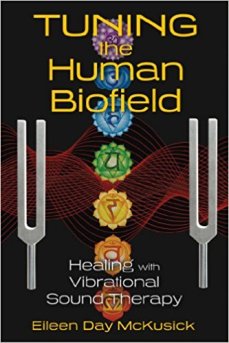
Tuning the Human Biofield – Eileen Day McKusick
(Buy from Amazon; Buy from The Book Depository)
A guide to the practice of Sound Balancing, using tuning forks to clear trauma stored in the human energy field
• Provides a precise map of the energetic biofield that surrounds the body, showing where specific emotions, memories, traumas, and pain are stored
• Details how to locate stored trauma in the biofield with a tuning fork and clear it
• 2015 Nautilus Silver Award
When Eileen McKusick began offering sound therapy in her massage practice she soon discovered she could use tuning forks to locate and hear disturbances in the energy field, or biofield, that surrounded each of her clients. She found these energetic disturbances correlated with the emotional and physical traumas her clients had experienced throughout their lives, the biofield acting as a record of pain, stress, and trauma from gestation onward. Passing the forks through these areas in the biofield not only corrected the distorted vibrational sounds she was hearing but also imparted consistent, predictable, and sometimes immediate relief from pain, anxiety, insomnia, migraines, depression, fibromyalgia, digestive disorders, and a host of other complaints. Now, nearly 20 years later, McKusick has fully developed her sound healing method, which she calls Sound Balancing, and created a map of the biofield, revealing the precise locations where specific emotions, memories, ailments, and traumas are stored.
In this book, McKusick explains the complete practice of Sound Balancing and provides illustrations of her Biofield Anatomy Map. She details how to use tuning forks to find and clear pain and trauma stored in the biofield. She reveals how the traditional principles and locations of the chakras correspond directly with her biofield discoveries. Exploring the science behind Sound Balancing, she examines scientific research on the nature of sound and energy and explains how experiences of trauma produce “pathological oscillations” in the biofield, causing a breakdown of order, structure, and function in the body.
Offering a revolutionary perspective on mind, energy, memory, and trauma, McKusick’s guide to Sound Balancing provides new avenues of healing for energy workers, massage therapists, sound healers, and those looking to overcome chronic illness and release the traumas of their past.
Disclaimer: This page contains affiliate links that may provide monetary compensation to help support the Whole Guidance Vision of Creating a Happy and Healthy Planet should you make a purchase. We very much appreciate and thank you for your support.
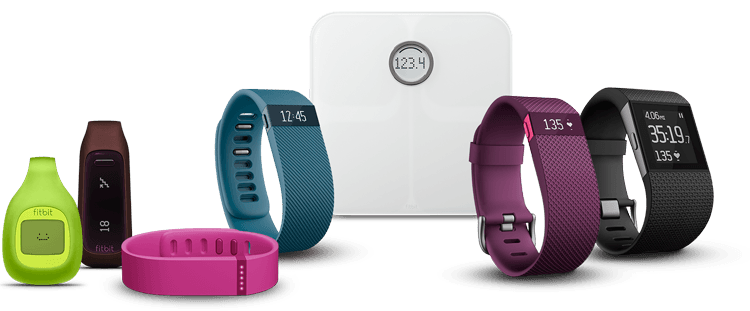
Fitbit Wireless Personal Trainer
(view product page)
Fitbit is the simplest way to get more fit during your busy life.
The Fitbit Wireless Personal Trainer tracks your full day’s steps, distance, and calories, allowing you to see how active you are and inspiring you to walk more and do more. And those small changes can add up to big results!
Fitbit can even measure how long and how well you sleep.
With free, easy-to-use online tools at Fitbit.com and new mobile apps, Fitbit lets you set goals, track your progress, and log food, weight, and other activities.
So, whether you’re looking to lose weight, continue your fitness program beyond the gym, or just get more active, Fitbit really helps you get the results you’re after.
Disclaimer: This page contains affiliate links that may provide monetary compensation to help support the Whole Guidance Vision of Creating a Happy and Healthy Planet should you make a purchase. We very much appreciate and thank you for your support.
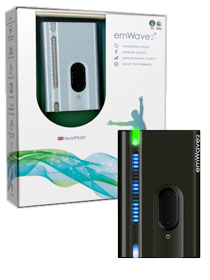
HeartMath Heart Intelligence Training
(view product page)
HeartMath is recognized as one of the world’s foremost authorities on emotional physiology, stress and optimal performance. Through their innovative technology they provide practical, scientifically validated methods that enable people to live more rewarding, healthy and productive lives personally and professionally. HeartMath have achieved global recognition for their groundbreaking products and services that have been proven to increase productivity while reducing the stress associated with living and working in this era of high-speed change.
The award winning emWave® and Inner Balance™ technology products from HeartMath offer a drug-free solution to stress, anxiety, depression, and more.
Used just a few minutes a day, this simple-to-use technology helps you transform feelings of anger, anxiety or frustration into more peace, ease and clarity.
For athletes and individuals training for health, HeartMath technology will give you a snapshot of your nervous system’s stress state indicating whether your body is ready for another hard high intensity workout or if you should take it easy with low intensity movements such as yoga, stretching, and massage.
Learn how to train your body to remain in a stress-free state even in the presence of perceived stress.
Disclaimer: This page contains affiliate links that may provide monetary compensation to help support the Whole Guidance Vision of Creating a Happy and Healthy Planet should you make a purchase. We very much appreciate and thank you for your support.
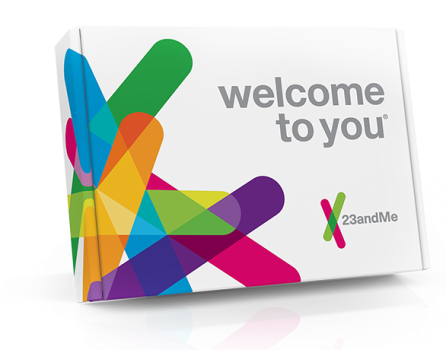
DNA Genetic Testing
(view product page)
23andMe is a DNA analysis service providing information and tools that allow you to learn about and explore your DNA. 23andMe services allow you to:
- Find out what your DNA says about you and your family
- Learn what percent of your DNA is from populations around the world
- Contact your DNA relatives across continents or across the street
- Build your family tree and enhance your experience with relatives
Along with ancestry and family information you also receive your entire genetic data in raw form with 23andMe. This gives you the option to use other online services such as Genetic Genie, Athletigen, and GeneKnot to interpret your raw data to get more information relating to potential health benefits and disease risks.
There was a time when testing your DNA and mapping your genetic code would cost 10’s of thousands of dollars. Today with the advancement of technology you can get your genome mapped for a fraction of the cost.
Disclaimer: This page contains affiliate links that may provide monetary compensation to help support the Whole Guidance Vision of Creating a Happy and Healthy Planet should you make a purchase. We very much appreciate and thank you for your support.

The way we buy groceries today is very much different to how our grandparents did their food shopping. While we still have local farmer’s markets we also have electronic versions of markets and shops making available foods and products from around the world.
You can find organic food and organic care products, quality home appliances, wellness gear, supplements, and more at the following online shopping websites.
Disclaimer: This page contains affiliate links that may provide monetary compensation to help support the Whole Guidance Vision of Creating a Happy and Healthy Planet should you make a purchase. We very much appreciate and thank you for your support.
